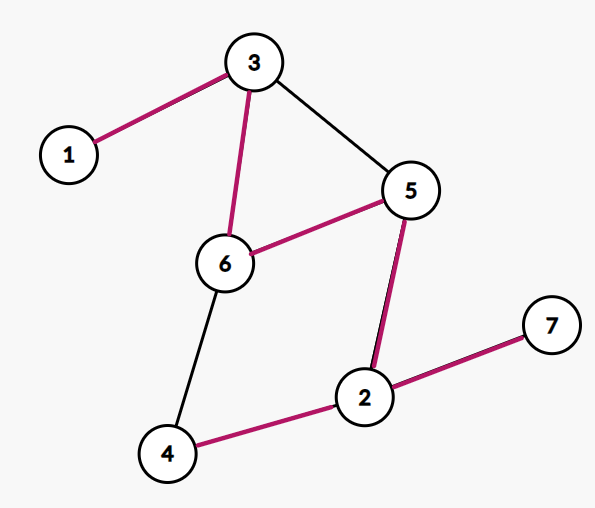tarjan求边双连通分量
点双连通分量见tarjan求点双连通分量
部分参考 lyd《算法竞赛进阶指南》
前置概念
给定无向图 \(G=(V,E)\)
- 桥(割边):若 \(e \in E\),如果删去 e 后图分裂成两个子图,那么 e 这条边就为桥(割边)。
- 时间戳:在深度优先访问时按照每个节点第一次被访问的时间顺序,依次给予 \(1\) ~ \(N\) 的标记,记为 \(dfn\) 数组。
- 搜索树:任选一个节点出发深度优先搜索,每个节点访问一次,所有发生递归的边组成的树。举例来说:图中红色的边即为搜索树中的一种,搜索树不唯一。

- 追溯值:记为 \(low\) 数组,定义为以下节点中的最小值:
1.subtree中的节点。
2.通过一条不在搜索树上的边能够到达subtree的节点。 - 边双连通图:一张不存在桥的无向连通图。
- 边双连通分量:简记为 “e-DCC”,表示无向连通图的极大边双连通子图。
追溯值的求法
- 先令 low[x]=dfn[x]
- 若在搜索树上,x 为 y 的父节点,则 low[x]=min(low[x],low[y])。
- 若无向边 (x,y) 不是搜索树上的边,则 low[x]=min(low[x],dfn[y])。
割边(桥)的判定方法
若无向边 (x,y) 为桥,则 x,y 应当满足以下条件:
- 边 (x,y) 在搜索树上
- 令 y 为 x 的子节点,那么 dfn[x]<low[y]
原理:
当dfn[x]<low[y]时,表示 y 及其子树上的点无法通过除 (x,y) 以外的边到达其他点,也就是说,若 (x,y) 不存在,那么 y 及其子树无法与其他部分连通,那么 (x,y) 满足桥的定义,即确认 (x,y) 为桥。
例:P1656 炸铁路
很明显,题目中的 key road 就表示割边,这是一道典型的求所有割边的模板
(他的数据范围小到可以枚举,但是不妨碍它是一道求割边的模板)
My code
#include<bits/stdc++.h>
using namespace std;
typedef long long ll;
const ll M=5009;
const ll N=159;
ll n,m;
struct edge{
ll to,nxt;
bool bridge;
} e[M<<1];
struct ANS{
ll from,to;
} ans[M];
ll nA;
ll hd[N],nE=1;
ll dfn[N],low[N],timer;
void add(ll u,ll v){
e[++nE]=(edge){v,hd[u],false};
hd[u]=nE;
}
void input(){
cin>>n>>m;
for(ll i=1;i<=m;i++){
ll u,v;
cin>>u>>v;
add(u,v);
add(v,u);
}
}
void dfs_tarjan(ll u,ll in_edge){
dfn[u]=low[u]=++timer;
for(ll i=hd[u];i;i=e[i].nxt){
ll v=e[i].to;
if(!dfn[v]){
dfs_tarjan(v,i);
low[u]=min(low[u],low[v]);
if(dfn[u]<low[v]){
e[i].bridge=true;
e[i^1].bridge=true;
}
}
else if(i!=(in_edge^1)){
low[u]=min(low[u],dfn[v]);
}
}
}
bool cmp(const ANS&a,const ANS&b){
if(a.from<b.from) return true;
else if(a.from>b.from) return false;
else if(a.to<b.to) return true;
else return false;
}
void solve(){
for(ll i=1;i<=n;i++){
if(!dfn[i]) dfs_tarjan(i,0);
}
for(ll i=2;i<=nE;i+=2){
if(e[i].bridge){
ans[++nA]=(ANS){min(e[i].to,e[i^1].to),max(e[i].to,e[i^1].to)};
}
}
sort(ans+1,ans+nA+1,cmp);
for(ll i=1;i<=nA;i++){
cout<<ans[i].from<<" "<<ans[i].to<<endl;
}
}
int main(){
input();
solve();
return 0;
}
边双连通分量的求法
将一张无向图中的所有桥删去后,无向图会分成若干个连通块,每一个连通块就是一个边双连通分量。
具体来说,在求桥的过程中,我们已经对所有桥的边进行了标记。再次深度优先搜索,不访问桥,对每一各连通块进行标记,则可以得到边双连通分量。
例:P8436 【模板】边双连通分量
模板题
My code
#include<bits/stdc++.h>
using namespace std;
typedef long long ll;
const ll N=500009;
const ll M=2000009;
ll n,m;
struct edge{
ll to,nxt;
bool bridge;
} e[M<<1];
ll hd[N],nE=1;
ll dfn[N],low[N],timer;
ll clr[N],dcc;
vector<ll> ans[N];
void add(ll u,ll v){
e[++nE]=(edge){v,hd[u],false};
hd[u]=nE;
}
void input(){
cin>>n>>m;
for(ll i=1;i<=m;i++){
ll u,v;
cin>>u>>v;
add(u,v);
add(v,u);
}
}
void dfs_tarjan(ll u,ll in_edge){
dfn[u]=low[u]=++timer;
for(ll i=hd[u];i;i=e[i].nxt){
ll v=e[i].to;
if(!dfn[v]){
dfs_tarjan(v,i);
low[u]=min(low[u],low[v]);
if(dfn[u]<low[v]){
e[i].bridge=true;
e[i^1].bridge=true;
}
}
else if(i!=(in_edge^1)){
low[u]=min(low[u],dfn[v]);
}
}
}
void dfs_clr(ll u){
clr[u]=dcc;
ans[dcc].push_back(u);
for(ll i=hd[u];i;i=e[i].nxt){
if(e[i].bridge) continue;
ll v=e[i].to;
if(clr[v]) continue;
dfs_clr(v);
}
}
void solve(){
for(ll i=1;i<=n;i++){
if(!dfn[i]){
dfs_tarjan(i,0);
}
}
for(ll i=1;i<=n;i++){
if(!clr[i]){
dcc++;
dfs_clr(i);
}
}
cout<<dcc<<endl;
for(ll i=1;i<=dcc;i++){
cout<<ans[i].size()<<" ";
for(ll j=0;j<(ll)ans[i].size();j++){
cout<<ans[i][j]<<" ";
}
cout<<endl;
}
}
int main(){
input();
solve();
return 0;
}
完结撒花thx~
本文来自博客园,作者:lemon-cyy,转载请注明原文链接:https://www.cnblogs.com/lemon-cyy/p/17674692.html



 浙公网安备 33010602011771号
浙公网安备 33010602011771号